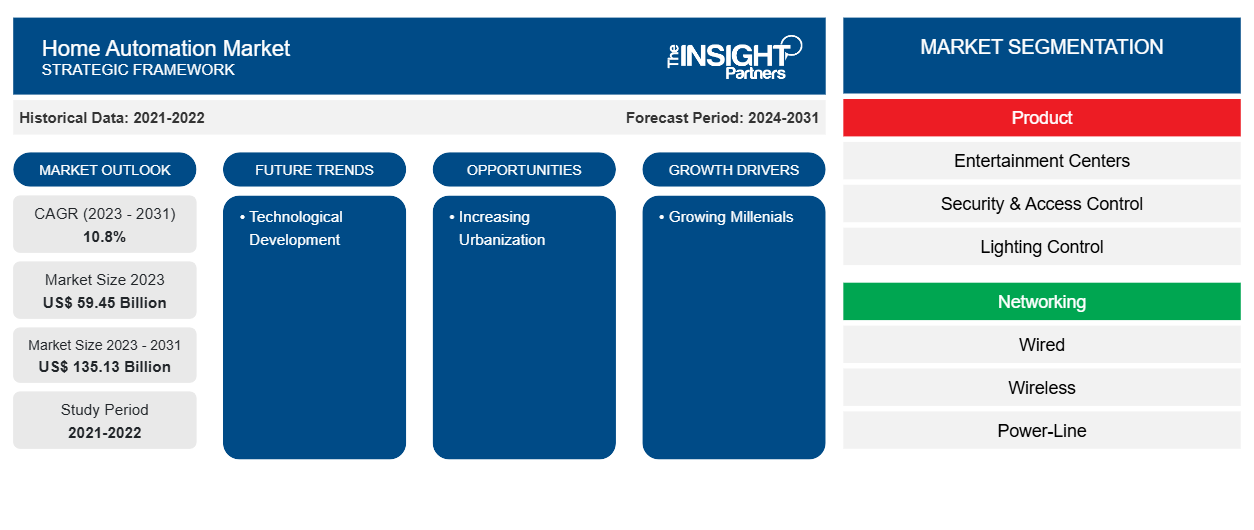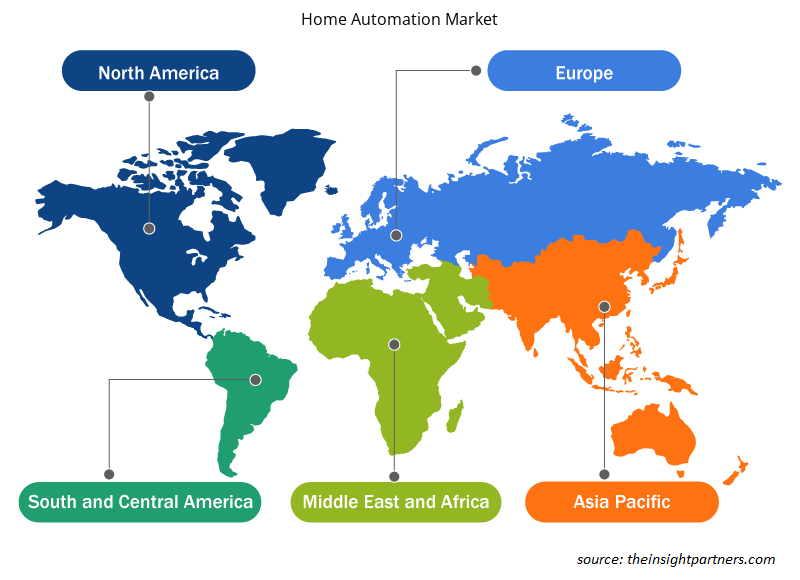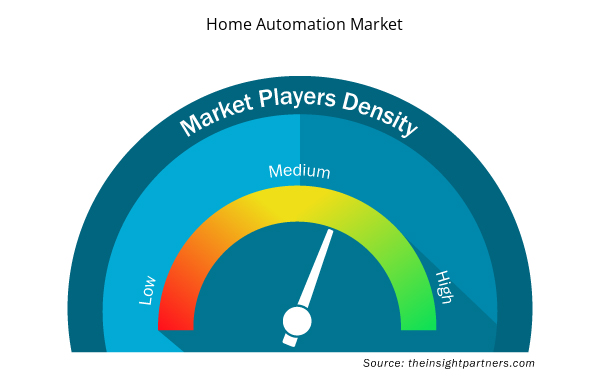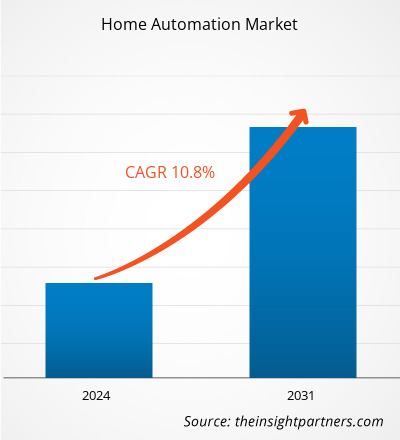The home automation market size is projected to reach US$ 135.13 billion by 2031 from US$ 59.45 billion in 2023. The market is expected to register a CAGR of 10.8% in 2023—2031. Growing home ownership and rapid urbanization in developing countries are likely to remain key home automation market trends.
Home Automation Market Analysis
The home automation market is growing at a rapid pace. The expansion of the global market is anticipated to be driven by customers' growing demand for features like interactive experiences and remote location operations provided by smart home automation. Furthermore, the growing popularity of smart assistants is anticipated to fuel market expansion. For example, Apple, Inc. introduced its second-generation HomePod with home automation-supporting capabilities and sensors in January 2023.
Home Automation Market Overview
The term "home automation" describes the automatic and electronic management of appliances, activities, and features in a home. But, it means an individual can easily utilize the Internet to control their home's features and utilities, making life more safe and convenient while also potentially saving money on household costs.
Customize This Report To Suit Your Requirement
You will get customization on any report - free of charge - including parts of this report, or country-level analysis, Excel Data pack, as well as avail great offers and discounts for start-ups & universities
Home Automation Market: Strategic Insights

- Get Top Key Market Trends of this report.This FREE sample will include data analysis, ranging from market trends to estimates and forecasts.
Customize This Report To Suit Your Requirement
You will get customization on any report - free of charge - including parts of this report, or country-level analysis, Excel Data pack, as well as avail great offers and discounts for start-ups & universities
Home Automation Market: Strategic Insights

- Get Top Key Market Trends of this report.This FREE sample will include data analysis, ranging from market trends to estimates and forecasts.
Home Automation Market Drivers and Opportunities
Growing Millenials’ Home Ownership to Favor Market
One of the main reasons behind the rising popularity of home automation systems is the rise in homeownership. Millennials comprise the bulk of individuals purchasing new homes. Additionally, the largest demographic investing in home automation systems is the millennia. Because of this, this population segment has a very high adoption rate of home automation systems. The Greater London Authority and the US Department of Commerce provide the dwelling unit data for the US and London. The use of home automation systems in residences is quite common in these areas. Rising consumer awareness of the advantages of smart home technology and technological developments have allowed security systems to function on a larger scale, offering more convenience and flexibility along with increased customer safety.
Increasing Urbanization
By 2025, Central Asia and Africa will probably see an increase in urbanization and industry. As smart cities grow, emerging countries are also seeing a tremendous increase in their urban population. The concentration of urban housing development in emerging economies has led to an increase in demand for better housing infrastructure. In the end, this would result in the installation of home automation systems in recently built, contemporary housing developments.
Home Automation Market Report Segmentation Analysis
Key segments that contributed to the derivation of the home automation market analysis are product and networking.
- Based on product, the home automation market is divided into entertainment centers, security & access control, lighting control, climate control, and outdoor automation systems. The entertainment centers segment is anticipated to grow in the forecast period.
- By networking, the market is segmented into wired, wireless, and power-line. The wired segment is anticipated to grow in the forecast period.
Home Automation Market Share Analysis by Geography
The geographic scope of the home automation market report is mainly divided into five regions: North America, Asia Pacific, Europe, Middle East & Africa, and South America/South & Central America. North America has dominated the home automation market. High technology adoption trends in various industries in the North American region have fuelled the growth of the home automation market. Factors such as increased adoption of digital tools and high technological spending by government agencies are expected to drive the North American home automation market growth. Moreover, a strong emphasis on research and development in the developed economies of the US and Canada is forcing the North American players to bring technologically advanced solutions into the market. In addition, the US has a large number of home automation market players who have been increasingly focusing on developing innovative solutions. All these factors contribute to the region's growth of the home automation market.
Home Automation Market Regional Insights
The regional trends and factors influencing the Home Automation Market throughout the forecast period have been thoroughly explained by the analysts at Insight Partners. This section also discusses Home Automation Market segments and geography across North America, Europe, Asia Pacific, Middle East and Africa, and South and Central America.

- Get the Regional Specific Data for Home Automation Market
Home Automation Market Report Scope
| Report Attribute | Details |
|---|---|
| Market size in 2023 | US$ 59.45 Billion |
| Market Size by 2031 | US$ 135.13 Billion |
| Global CAGR (2023 - 2031) | 10.8% |
| Historical Data | 2021-2022 |
| Forecast period | 2024-2031 |
| Segments Covered |
By Product
|
| Regions and Countries Covered | North America
|
| Market leaders and key company profiles |
Home Automation Market Players Density: Understanding Its Impact on Business Dynamics
The Home Automation Market market is growing rapidly, driven by increasing end-user demand due to factors such as evolving consumer preferences, technological advancements, and greater awareness of the product's benefits. As demand rises, businesses are expanding their offerings, innovating to meet consumer needs, and capitalizing on emerging trends, which further fuels market growth.
Market players density refers to the distribution of firms or companies operating within a particular market or industry. It indicates how many competitors (market players) are present in a given market space relative to its size or total market value.
Major Companies operating in the Home Automation Market are:
- Johnson Controls
- Siemens
- Legrand
- Schneider Electric
- Resideo Technologies, Inc.
- Snap One, LLC
Disclaimer: The companies listed above are not ranked in any particular order.

- Get the Home Automation Market top key players overview
Home Automation Market News and Recent Developments
The home automation market is evaluated by gathering qualitative and quantitative data post primary and secondary research, which includes important corporate publications, association data, and databases. The following is a list of developments in the market:
- In January 2023, - Skyworks Solutions, Inc. and Semtech Corporation introduced the SKY66423-SX1261 reference design for low-power wide-area networks (LPWAN). The SKY66423-SX1261 combines Semtech’s LoRa Connect SX1261 transceiver with Skyworks’ SKY66423 front-end module (FEM) for use in a variety of industrial and smart city applications. The proliferation of wireless devices operating in the industrial, science and medical (ISM) bands contributes to noise interference and creates reliability challenges for long-range and power-sensitive applications. By increasing the transmit output power and reducing the receiver’s system noise figure, the SKY66423-SX1261 addresses these challenges and provides an effective solution for industrial IoT deployments using LoRaWAN.
(Source: Skyworks Solutions, Inc., Press Release, 2023)
- In Jnauary 2023, Shelly, a division of Allterco Robotics, Ltd, announced the launch of 8 new smart home automation devices at the Consumer Electronics Show (CES). One of the fastest growing IoT brands in the world, Shelly has added advanced functionality to their newest devices while remaining true to the brand’s core benefits of affordability, interoperability, accessibility, energy efficiency, and ease of installation.
(Source: Shelly, Press Release, 2023)
Home Automation Market Report Coverage and Deliverables
The "Home Automation Market Size and Forecast (2021–2031)" report provides a detailed analysis of the market covering below areas:
- Market size and forecast at global, regional, and country levels for all the key market segments covered under the scope
- Market dynamics such as drivers, restraints, and key opportunities
- Key future trends
- Detailed PEST/Porter's Five Forces and SWOT analysis
- Global and regional market analysis covering key market trends, major players, regulations, and recent market developments
- Industry landscape and competition analysis covering market concentration, heat map analysis, prominent players, and recent developments
- Detailed company profiles
- Historical Analysis (2 Years), Base Year, Forecast (7 Years) with CAGR
- PEST and SWOT Analysis
- Market Size Value / Volume - Global, Regional, Country
- Industry and Competitive Landscape
- Excel Dataset



Report Coverage
Revenue forecast, Company Analysis, Industry landscape, Growth factors, and Trends

Segment Covered
Product and Networking

Regional Scope
North America, Europe, Asia Pacific, Middle East & Africa, South & Central America

Country Scope
US, Canada, Mexico, UK, Germany, Spain, Italy, France, India, China, Japan, South Korea, Australia, UAE, Saudi Arabia, South Africa, Brazil, Argentina
Frequently Asked Questions
The global home automation market is expected to reach US$ 135.13 million by 2031
The key players holding majority shares in the global home automation market are Johnson Controls, Siemens, Legrand, Schneider Electric, Resideo Technologies, Inc., Snap One, LLC, ABB, Crestron Electronics, Inc., Leviton Manufacturing Co., Inc., Lutron Electronics Co., Inc.
Advent of IoT, big data, and machine learning are impacting the home automation, which is anticipated to play a significant role in the global home automation market in the coming years.
Growing millenials’s home ownership and interactive experiences offered by smart home automation are the major factors that propel the global home automation market growth.
The global home automation market was estimated to be US$ 59.45 billion in 2023 and is expected to grow at a CAGR of 10.8 % during the forecast period 2024 - 2031.

 Get Free Sample For
Get Free Sample For